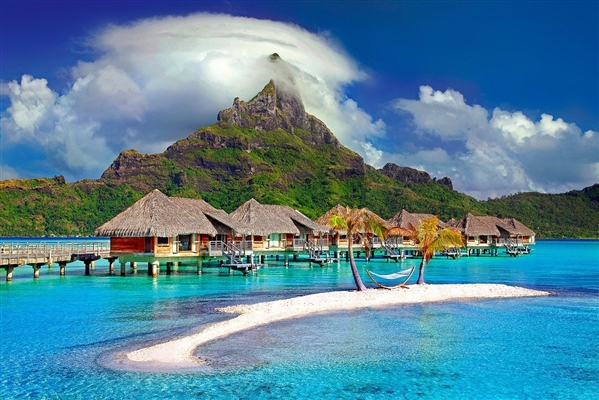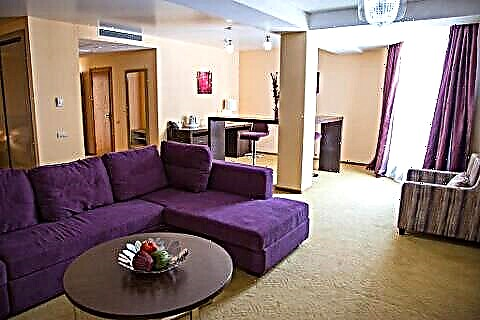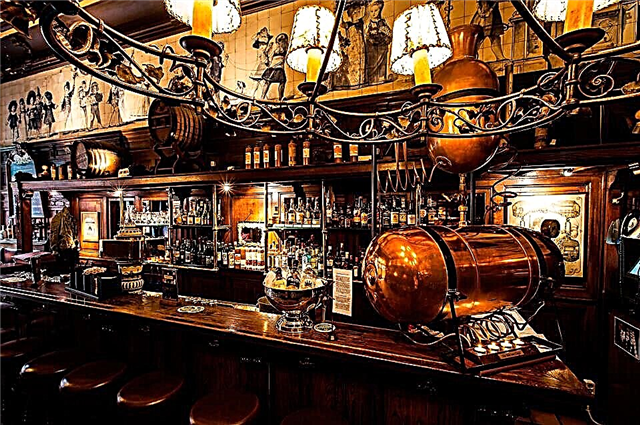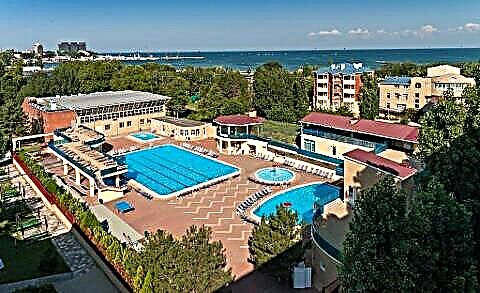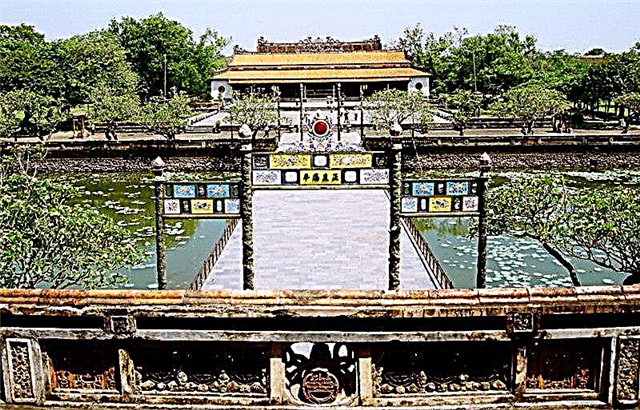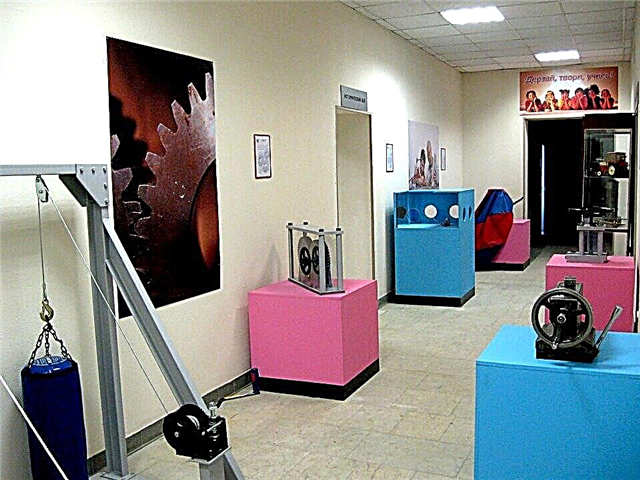“Eyelashes pointed with fir-tree over the blue eyes of the lakes”, - so figuratively and romantically described the poet Ryzhov Karelia in the poem “Karelia will dream for a long time”. In collaboration with A. Kolker, they created a soulful song with the same name, performed for the first time by the unforgettable Maria Pakhomenko. The land of blue lakes, dense forests captivates the imagination with the beauty and richness of nature.
The capital of the republic - the city with the eloquent name Petrozavodsk (1777) was founded in Prionezhie. The town-forming enterprise was the plant where the cannons were cast, built under Peter I. To get acquainted with the interesting history of the city and the republic, you need to visit the glorious museums of Petrozavodsk.
National Museum of the Republic of Karelia
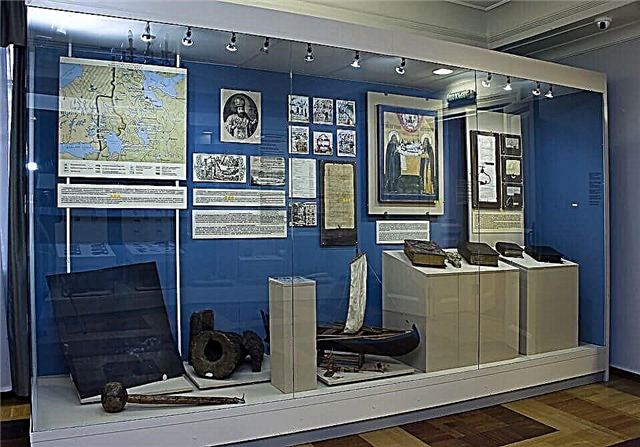
The oldest museum institution (1871) in the northwestern part of Russia is located in the old city center, in the former buildings of the Olonets administration. The buildings themselves are monuments of urban Karelian architecture, its first examples.
All natural, cultural and historical aspects of the unique region are reflected in 22 exhibition halls. The exhibition "Natural features of Karelia" in the most detailed way acquaints with all the variety of living and inanimate nature.
The exhibitions “Stone Chronicle. Archeology of Karelia ". Here are, for example, granite slabs with hieroglyphs left 8 thousand years ago. A detailed history of the development of Karelia in the 9th-20th centuries is presented in the section "Northern Borderlands", Petrovskie Zavody, "City-Factory", "By the Highest Decree".
Pictures of the life of provincial Petrozavodsk appear before the visitors of the exposition "The Provincial Capital", which reflects the life of the townspeople of the early 20th century. There are playrooms for children and family rooms where costume role-playing games are organized, interactive classes are held.
Children can play with Karelian-Finnish household items, national toys. There are 2 museum branches in the vicinity of Petrozavodsk: the Marcial Waters Resort and the Sheltozero Museum of Vepsian Ethnography.
Industrial History Gallery

In the very center of Petrozavodsk, among the historical sights of the city, there is the building of the former OTZ polyclinic (Onega Tractor Plant). In 1967 a museum of industrial history of the capital of Karelia was opened there.
Now the institution, being its successor, is called the Gallery of Industrial History. If someone thinks that her visit is of little interest, then this will be a delusion. Here, both children and adults will not get bored, tracing the entire path of industrial development of the republic from the Petrovsky plant to the crisis 90s.
This institution is especially relevant now, in the era of the dismantling of many industrial enterprises. In the 1st hall, interactive models of the workshops of the Peter the Great era were created, the technological process of casting cannons is presented. The expositions reflect the industrial development of the city during the tsarist era. Samples of weapons are on display.
The equipment of the 2nd hall is dedicated to the formation of the Soviet industry. The first wooden tractor, created at the plant, is receiving great attention. The stands display materials introducing the plant traditions and outstanding people of the enterprise.
In addition to demonstration expositions, a scientific and technical hall has been organized. It conducts physical experiments, visitors can experience various mechanisms and devices.
Museum of Fine Arts of the Republic of Karelia

The historic building of the late 18th century, which once housed a men's gymnasium, today houses a solid cultural institution - a repository of painting masterpieces.
The architectural monument has been used for various establishments over the years. The Museum of Fine Arts was organized in 1960, based on the collection of works from the local history museum of the republic.
All major museum formations of the country rendered assistance in replenishing the fund. Today in the collection of the institution there are almost 12 thousand art exhibits, and in the library fund - 17 thousand documents.
The entire spectrum of fine art, embodied in beautiful works, is reflected in museum exhibitions. It presents the work of ancient Russian icon painters, artists of the 18-19th centuries, applied folk art of Karelia, canvases by masters of the brush from Western Europe.
Famous paintings are exhibited in the halls: "The Crucifixion of Christ" by Vasnetsov, "Landscape with a River" by Polenov, "Head of Christ" by Kramskoy, etc. The pearls of icon painting of the 16-18th centuries, collected in Karelian villages, are presented. Among them are "Assumption", Saints Eustathius and Tryphon "," Saturday of All Saints ". One cannot but admire the works of woodcarvers - icons-bas-reliefs of the 17th-19th centuries.
Museum of Precambrian Geology

The geological and stone chronicle of the Earth's development reveals its secrets in an interesting institution founded at the Karelian Institute of Geology in 1961 - the Museum of Precambrian Geology. The period (about 3.8 billion years) when organisms appeared on our planet that were imprinted in sedimentary rocks is called the Precambrian. The idea to create exhibition expositions came from the staff of the institute, when a solid collection of stone rocks collected during field expeditions was accumulated.
Now in the fund of the museum, located in 2 halls, more than 3.5 thousand samples of rocks are stored. The kaleidoscopically colorful world of stone and mineral formations cannot but delight. In the lower hall (1st floor), relief samples and Quaternary deposits of Karelian strata are presented. Looking at the colorful exhibits, one can trace the evolution of life on Earth.
The collection of minerals, stromatolites, natural stone of Karelia for architectural purposes is unique. The floor, laid with stone mosaics, granite stairs, tables made of processed natural blocks act as visual objects here.
Kuchevsky's house

On the Neglinskaya embankment there is an architectural monument of the first half of the 19th century. - House of Kuchevsky (1827). This example of an old wooden building in the city is interesting for its architectural personality. But the personality of the former owner of the house is also noteworthy.
He was a well-known political and public figure in pre-revolutionary Karelia, in charge of forestry affairs. Kuchevsky's house today is an object of the Kizhi Museum-Reserve. The building until 1979 was located on the street. Kuibyshev, and then it was transported to the district of historical buildings and restored in its authentic form.
The central facade of the 1-storey building faces the street. Kuibyshev. It is built in the shape of a cross, the main part of which is a parallelepipid. A mezzanine is attached from 2 sides, with loggias decorated with 6 wooden columns and an openwork fence made of carved balusters. The main entrance is designed as a platform under a 2-pitched roof.
The 2nd entrance is located on the eastern façade. The walls of the house are sheathed on the outside with gray painted planks. Inside, authentic paneled doors and a wooden staircase with carved balusters have been preserved. The appearance of the house is in harmony with the white birch trees that surround it.
Maritime Museum "Polar Odysseus"

A vivid history of the era of wooden shipbuilding appears before the visitors of the unique institution "Polar Odysseus". In it, visitors get acquainted with copies of various sailing ships participating in sea expeditions in the World Ocean. And modern "odyssey", enthusiasts of the Marine Club, created back in 1986, sailed on them.
The club began with the first wooden boat "Polar Odyssey" (1978), on which engineer V. Dmitriev made his maiden voyage on the lakes and rivers of Karelia. Other sailing enthusiasts followed suit.In 1986 they formed the Polar Odysseus Research Club of Sea Travelers.
Today the club has become a large maritime historical and cultural center (MCIK). It has its own shipyard, which has already built more than 40 wooden sailing ships. All of them can be seen in museum exhibitions opened in 1994.
It is very interesting to learn the history of travel on the waves of each ship. The museum contains the richest material of scientific and historical significance. The main exhibit here is the boat "St. Nicholas", an indispensable participant in all festivals and holidays. The goal of the organizers of MCIKA is to reach the international level of yachting and sea tourism.
Military Glory Center

It would be surprising if the city, which inherited the name of a military plant that produced cannonballs and cannons, did not have a Center of Military Glory. People come here to get acquainted with the history of military equipment, with the exploits of the defenders of Karelia throughout the centuries of its existence.
All the wars in which Russia took part were reflected in the expositions. Various artifacts, installations, stands tell about the glorious military pages of the republic. They began in 1704, when the first cannon for participation in the Northern War was cast at the Petrovsky plant.
Among the museum rarities found on the defense lines, there is a sample of the first Russian helmet. It is made of steel used for making shovel bayonets. Several types of protective helmets are presented, including the first Soviet and French ones.
Attention is drawn to a piece of a tree trunk with a Mosin rifle bayonet embedded in it. In total, the exposition contains 12 types of these weapons. The stand of the same name reflects the trench creativity of the soldiers. Homemade lighters, cigarette cases, soap dishes, cartridges testify to the talents of the craftsmen who are waiting for the battle in the trenches. Newspapers of the war years, reports, documents of fighters excite the soul, forcing them to be imbued with a sense of gratitude and patriotism.
Tatyana Kalinina's doll house

The multi-talented Karelian artist created the 1st private art gallery, calling it "Doll's House", in 1999. This is really a warm home corner where amazing characters live.
The artist's fantasy and hands have created extraordinary doll-like creatures endowed with a unique charisma. It is impossible to leave here, looking at the representatives of the world of fairy tales, myths, legends, books and cartoons for a long time.
The gallery consists of 3 halls and workshops where miraculous dolls will be "born". The master used a variety of natural and synthetic materials in the most unexpected ways, working on the collection since 1992. Each of her brainchildren has its own character, manner, habits and seems alive, thanks to the talent of their creator.
Guests are greeted by a portrait of Kalinina, where she is depicted together with the Pushkin doll, made for the play about Tsar Saltan. In the 1st, the Fairytale Hall, Lukomorya Oak and Apple tree with rejuvenating apples "grow".
Almost all the characters of Pushkin's fairy tales live in this lovely house: Tsar Saltan, the Swan Princess, Koschey the Immortal, the scientist Cat, etc. Very interesting installations "In the Kalevala expanses", inhabited by Brownies, Leshims, Waters, Dvorovs, Sudovs.
There are also previously unknown persons created by the imagination of the craftswoman: Topuriki, Diviki. In the 2nd hall, the author's works of puppeteers are demonstrated. The constantly growing collection is represented by dolls of different genres.
Museum of military history

The cultural and historical institution dedicated to the military fate of Karelia was created by a group of enthusiasts with the collected funds (2017). These are members of the public organization "Officers of Russia", who have collected almost 1,000 exhibits in 3 years.
The purpose of creating such an institution is the implementation of the patriotic education of young people, a tribute of gratitude and eternal memory to the fallen soldiers. Lessons of Courage, local history classes, and various meetings are held here. Recently, the museum expositions were placed in a new building, on the street. Zaitsev.
Among the main exhibits is the returned Red Banner, lost in the Soviet-Finnish war. Each item on display here is the result of a painstaking search, so each of them is unique.
Soldiers' uniforms, personal belongings, camping teapots, bowlers, ammunition boxes, commander's backpacks "paint" a complete picture of military life. An ancient accordion with a sailor's peakless cap evokes thoughts of the dead sailors. The installation presents a soldier's dugout made of round logs. When visiting an institution, a feeling of gratitude to its organizers arises.
Children's Museum Center of the Kizhi Museum-Reserve

Founded in 1994, the complex institution DMC (children's museum center) at the Kizhi Museum unites more than 50 cultural and educational institutions. Its goal is to attract children and young people to the preservation and study of the cultural and historical heritage of the Karelian Republic, its natural resources.
The DMC of the Kizhi Museum actively participates in the educational process of schoolchildren, uniting the creative efforts of 150 museum employees, teachers and parents. Every year more than 2 thousand children of different ages, starting from the age of 4, participate in the projects of the center.
For example, for kids 3-4 years old, a cognitive program "Introduction to the objective world" has been developed, which is regularly improved. Preschoolers (5-6 years old) immerse themselves in research on the topic of "Home" in a historical perspective.
Primary school students deal with the problem of "Museum and culture", revealing the relationship between these concepts. During the holidays, various competitions, they begin to understand the important role of museums in preserving the traditions of national culture. Schoolchildren of the middle grades get acquainted with the "City Studies", presented in the evolutionary development from antiquity to the present day.
For high school students, seminars, festivals and conferences are held on the topic of the material and spiritual culture of the Karelian peoples. There is a Summer University on Kizhi Island, with a cultural and educational program for students and adults.
In the summer, a museum and ethnographic school opens here, in the projects of which more than 3 thousand children from Karelia, Russia, Finland, Belarus and Lithuania have already participated. The Fund for Children's Creative Works contains almost 3 thousand copies today.
Karelian courtyard

The highlight of a trip to Karelia will undoubtedly be a visit to the ethnographic museum-estate "Karelian courtyard". It is located in the village of Uzheselga (4 km from Petrozavodsk). Although construction and repair work continues here, tourists have something to see and wonder.
Coming here, you make a kind of travel in time, you are transported to the Karelian antiquity, you get acquainted with the national rural traditions. It is interesting to observe the development of the estate, to participate in the events held there.
"Karelskoe podvorie" is a complex of 8 buildings, each of which reflects some side of the people's life. How nice it is to be in the interior of the wooden hut of the Karelians of the late 19th and early 20th centuries. This is how the house is decorated, stylized as a Karelian hut: homespun rugs, embroidered curtains, benches, a chest, bunches of dried herbs.
There is a House-Museum in the estate with interactive guided tours. The Visitor Center provides information on a variety of tourist destinations and services. In the Workshop, where they are engaged in the restoration of exhibits and the production of handicrafts, visitors are trained in national crafts.
Acquaintance and reconstruction of ancient rituals and technologies takes place in the Laboratory House. And in the gambling house folk amusements, nursery rhymes and entertainment are organized.
The cultural center prepares musical and poetic retro programs, organizes folklore festivals. In the Tavern with an antique-styled interior, guests are treated to national dishes, wickets and tea pies.
Shungite Center

As the Baltic states are proud of amber, so Karelia has the right to be proud of the fact that in its depths there is a unique mineral shungite, which is more than 2 billion years old. The healing properties of shungite, which cured nun Martha (mother of the 1st Russian Tsar Romanov), have been known for a long time.
The Shungite Center presents a detailed history of amazing shungite rocks. The expositions introduce a wide range of their use in industry, medicine and science in their beginning. Visitors will learn about the endless prospects of using this truly invaluable natural material in all areas of development of the republic and country.
The task of the Shungite Center is to popularize the stone and its derivatives. Here visitors will learn about the antibacterial properties of the mineral, about the ability to absorb electromagnetic radiation, which is very important in the age of computerization and cell phones.
The hall contains materials about the development of the Zazhoginsky shungite deposit (so far the only one in the world). The exhibition of souvenirs made from shungite raw materials: figurines of animals and birds is of great interest. The center is located in a beautiful modern building on the Varkaus embankment in Petrozavodsk.
Bringing Down the House

Want to walk on the ceiling instead of the floor, see furniture hanging overhead, or splash in a ceiling-mounted bathroom? Such an incredible adventure awaits you when you visit an unusual attraction for the whole family - Upside Down House.
It is located in Petrozavodsk, on the street. Trade unions. The internal area of the building is 100 sq. m, divided into 6 rooms. They are unusual in that the floor and ceiling in them are reversed, creating an inverted space.
There is a bedroom, a nursery, a living room, a kitchen, a bathroom - all rooms are appropriately furnished. The 6th room is gravitational, in which everyone can experience the feeling of weightlessness. The guests of the Upside Down House try to prepare breakfast in the kitchen, where a table with dishes and chairs "hang" over their heads.
If desired, they can lie on a bed floating in the air, take a shower in an inverted bath. Everyone leaves here only with positive emotions.
Museum of the history of the locomotive depot

At the initiative of the chief technologist of the locomotive enterprise of Petrozavodsk, Gennady Laptev, the Museum of the history of the locomotive depot was opened in 2013. The main exhibit of the institution is the ER steam locomotive, built back in the 30s.
A carefully restored steam locomotive that transported military supplies in 1941-45 was installed in a place of honor. ER is the only one on the North-Western Railway that has fully retained all its component parts.
200 sq. m of the museum area, there are 600 exhibits. They were selflessly collected by the members of the depot working collective. The whole history of the railway business in Karelia, from the appearance of the private Olonets railway in 1916 to the present.
Here you can find locomotive parts from different eras, drawings, technological projects. The process of evolution from a steam locomotive to an electric locomotive can be observed by viewing thematic exhibitions.

